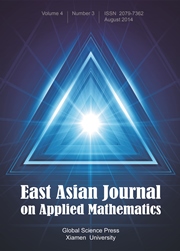Article contents
A High Order Well-Balanced Finite Volume WENO Scheme for a Blood Flow Model in Arteries
Published online by Cambridge University Press: 31 January 2018
Abstract
The numerical simulations for the blood flow in arteries by high order accurate schemes have a wide range of applications in medical engineering. The blood flow model admits the steady state solutions, in which the flux gradient is non-zero and is exactly balanced by the source term. In this paper, we present a high order finite volume weighted essentially non-oscillatory (WENO) scheme, which preserves the steady state solutions and maintains genuine high order accuracy for general solutions. The well-balanced property is obtained by a novel source term reformulation and discretisation, combined with well-balanced numerical fluxes. Extensive numerical experiments are carried out to verify well-balanced property, high order accuracy, as well as good resolution for smooth and discontinuous solutions.
Keywords
MSC classification
- Type
- Research Article
- Information
- Copyright
- Copyright © Global-Science Press 2017
References
- 1
- Cited by


